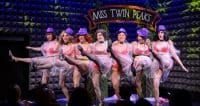“Hoover’s quirks included a ban on drinking coffee on the job and wearing colored shirts. Drinking coffee conflicted with the image of hardworking supermen who never took a break. As a result of Hoover’s dictum, agents would take time off from work to search for a coffee shop instead of drinking coffee at their desks.” —Ronald Kessler, The Secrets of the FBI, p. 31
Among the elements of the original two seasons of Twin Peaks (1990-91) that fans and scholars have obsessed over, the foods and beverages are near if not at the top of the list. The lore is well known of coffee and pie parties held on original air dates, and the massive quantities of donuts laid out at fan festivals are well documented, from Mark Altman’s 1991 unofficial visitor’s guide to the encyclopedic 2016 book, Twin Peaks FAQ. A wide range of online forums feature more musings on coffee, pie, and donuts than could be read in an average human lifetime. The fanzine Wrapped in Plastic has a long catalog of articles that engage food. And within the academic zone of writings on Twin Peaks, David Lavery’s introduction to the first volume of Twin Peaks criticism is called “The Semiotics of Cobbler,” and Lorna Piatti-Farnell has an insightful essay on food and spaces of consumption to name just two examples. My own contribution on the original seasons’ comestibles, “Dale Cooper and the Mouthfeel of Twin Peaks,” outlines how food scenes capture the fundamental class antagonism and ecological awareness that shaped what was happening in the town of Twin Peaks. All of that scholarship explores the original seasons in exciting ways, and now is the time for new essays to explore foods and beverages in The Return.
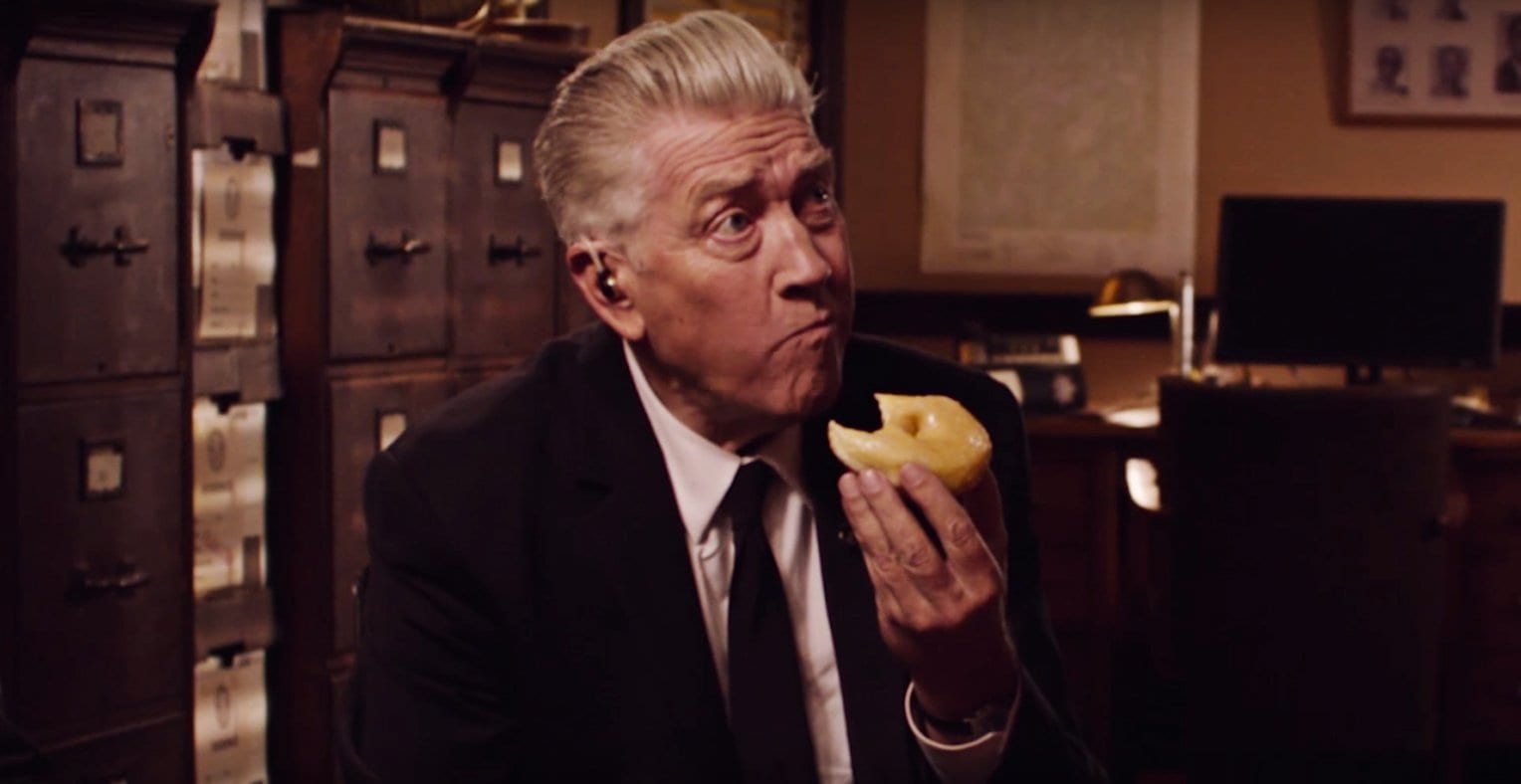
In this essay, I focus on two specific food networks in Twin Peaks: The Return. By food networks, I refer to sets of scenes that arguably connect with each other through a mutually shared beverage or food or through other narrative links. One of these networks is comprised of the scenes that involve Bloody Marys. Close analysis of the form and content in this network reveals the seemingly paradoxical synthesis of subtle nuance and unflinching brutality in the depictions of misogyny in the latest season of Twin Peaks. In the first critical book on Twin Peaks, Dr. Diane Hume George astutely noted in her essay “Lynching Women: A Feminist Reading of Twin Peaks” a lack of feminist critique, suggesting that perhaps the powerful mysteries of the series magnetized attention away from its gender representations and problematics. In the years since that essay, feminist analyses of Twin Peaks have increased and intensified with recent work by Lindsay Hallam in her Twin Peaks: Fire Walk With Me monograph, in the Devil’s Advocate series from Auteur and Alice Bolin in her book Dead Girls: Essays on Surviving an American Obsession as especially useful instances.
The second part of the essay assembles and explores select scenes that involve diverse comestibles while connecting with each other as nodes in a food network of overcoming a culture of misogyny. Specifically, from a food network that links Big Ed Hurley, Nadine Hurley, Norma Jennings, and Bobby Briggs, I extrapolate how their interactions positively counterbalance the more horrific registrations of misogyny in the Bloody Mary constellation.
And, as a bonus feature to the essay, I’ve embedded a database of the foods and beverages in The Return so that anyone can run queries to experiment and see what constellations emerge in the results, what questions they beg, and what answers might follow. Use the database here:
Twin Peaks
Spreadsheet style Web database builder. Build cloud databases with spreadsheet UI and embed to your website.
The first time we see Sarah Palmer in The Return, she is sipping a Bloody Mary while sitting on her living room sofa, watching a violent wildlife show on a truly massive flat screen television. Grace Zabriskie delivers a subtle performance in the scene, nursing the deep red drink that stands out against the beige background and watching the show with a blank expression that conveys a sense of loneliness and boredom. During this initial part of the scene, the camera is positioned in the room to capture Sarah and the television screen in the shot. Then, just as lions bring a water buffalo down to the ground, one lioness tears viciously at it until blood smears her maw. The red liquid visually pops against the darkness of the night, and then the scene cuts to a different camera position nearly in front of Sarah to show her face’s reactions as well as the television images reflected in the mirrors on the wall behind her. In response to the sudden splash of blood on the screen, Sarah’s eyebrows raise up, her hair shifts up and back, and her gaze intensifies, though she doesn’t appear to comprehend the sudden fascination she is feeling. The shift in camera position literalizes the idea that Sarah reflects the lioness, both with mouths lapping at blood red liquids. Sarah’s emergence from boredom signals that she recognizes something, some part of herself, in this scene of consuming the blood of another who is suffering and afraid.
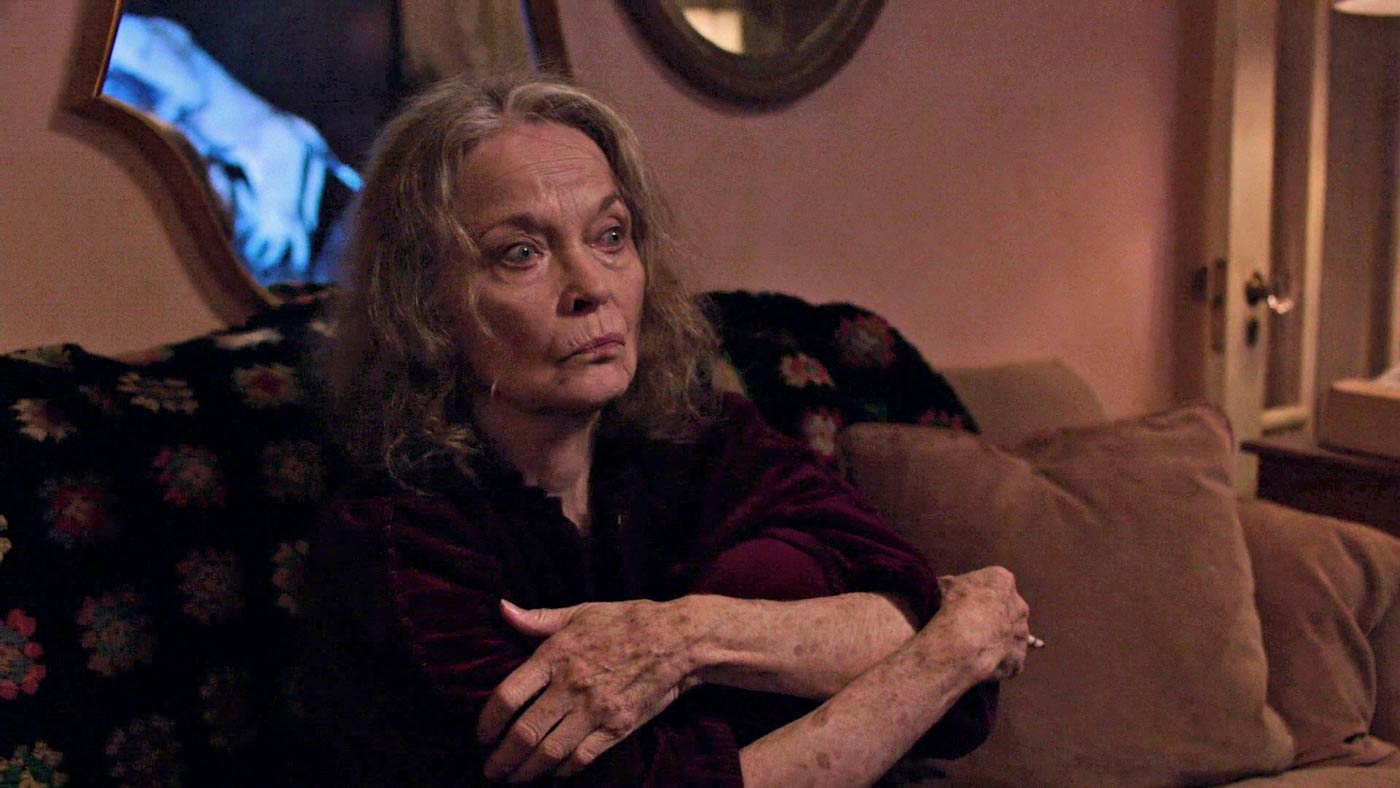
Now, since The Return suggests that Sarah has long been inhabited by, or connected with, Judy, the significance of this scene expands all the back to the pilot episode that aired in April 1990. One needs to revisit the sequence in the pilot, the one starting with Sarah calling Laura for breakfast and later her anguished scream heard over the still-dangling telephone receiver in the lobby of the Great Northern. To see this in light of The Return is to wonder afresh what role Sarah played as enabler, or even perpetrator, of her daughter’s years of sexual abuse.
Not only does the pilot scene open with a verbal invocation of food, but the shot of Sarah in the kitchen includes the first food doubling in Twin Peaks, making it a formal twin with Sarah’s first appearance in The Return. That food double was the side by side boxes of trademark-genericized Cap’N Crunch cereal and Quaker oats with color schemes and hats that comprise a visual rhyme. Both kinds of cereal are produced by the same corporation, and their double presence is suggestive of Sarah’s (and all the Palmers’) doubleness as the Captain is a naval soldier and the Quaker is a religious pacifist—in capitalist consumption, these antagonists of war and peace, violence and love, are one and the same.
I hesitate to go too far in asserting these iconic hats resemble an inverted owl cave/Judy symbol, but it does align with Sarah’s consumption of Bloody Marys in The Return as unconscious attempts to alert herself to Judy’s presence. Consequently, those unforgettable screams in the pilot episode when she learns that Laura’s dead may, in fact, have emanated from Judy losing Laura as the one she was cultivating through BOB. Put simply, the first Bloody Mary in The Return echoes Sarah’s scene in the pilot and makes a case for paying strict attention to misogyny throughout the entirety of Twin Peaks.
For among the myriad things the series does amazingly is drag spectators into this darkness to engage unflinchingly with how misogyny really functions inside the series and out—something I’ve argued in my essay “A Reflection on Why Agent Tamara Preston Has the Stuff”—as well as inspire spectators to work for change.
Revisiting Sarah Palmer and her role in Laura’s life continues with a twist in the next Bloody Mary scene in The Return. The scene appears in Part 12 and brings us to Sarah walking with the slow and seemingly hypnotized energy that grocery store aisles can induce in shoppers. She stops in the liquor section to resupply the vodka for her Bloody Marys, and her face registers just a modicum of disappointment after a reach to the back of the shelf informs her that there are only three bottles of her brand. But then, repeating the emotional trajectory of the first Bloody Mary scene, the emotional register spikes at the checkout. Triggered by a change to the store’s point-of-sale jerky inventory, Sarah begins asking Victoria, the young woman ringing up her purchases, about the new meat before pivoting through the provocatively ambiguous question “Were you here when they first came?” to an ominous warning to Victoria that “men are coming” and that the young woman needs to watch out because things can happen. Then, it’s as if Sarah is momentarily aware of two antagonistic forces battling within her, and she abruptly leaves the store, leaving behind her Bloody Mary supplies and muttering angrily to herself. The scene closes on Victoria and Oscar, a young man bagging groceries, looking to each other to confirm that what just happened was indeed weird, and Oscar implies he’ll deliver the groceries to Sarah as he knows where she lives.
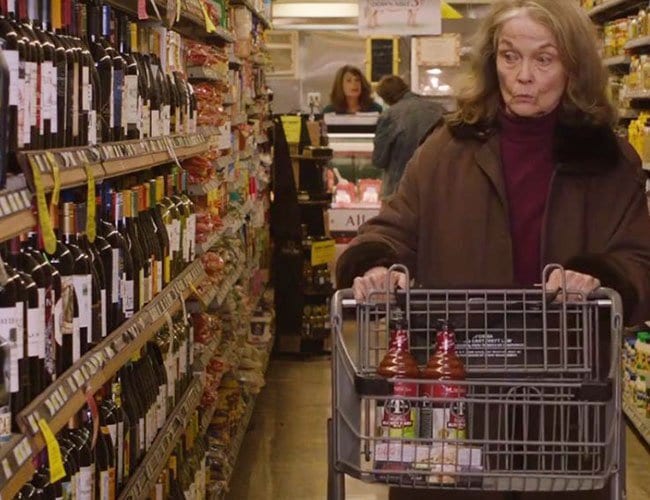
Although this scene comes well after Sarah watched the lions gorge on water buffalo, the Bloody Mary and jerky call back to that scene. Recall that the previous scene’s impact came about by paralleling Sarah’s Bloody Mary red mouth with that of the lioness on the television tearing mouthfuls of beef away from its struggling prey. In this new scene, the barely-there annoyance at the store’s low vodka inventory is a tonal judo move that calms spectators before the intensely startling jerky transaction. The weirdness conjured through this tonal shift resonates with Sarah’s interior antagonistic attunement to both protective and predatory gestures—to being a mother and being Judy. Sarah’s statement that “men are coming” and that Victoria needs to “watch out because things can happen” indicate a desire to protect this young woman.
Sarah invests her words with ominous intensity to leverage the experiences of her own life, to prevent one more young woman from being subject to the violence of the structures of misogyny. In this gesture of protective warning, Sarah breaks through to a traumatic event in her own past as her
warning shifts from the generic “things can happen” to the personal “something happened to me.” In fact, many horrific eruptions of misogyny have affected Sarah’s life—from losing Laura and Maddy to who knows what sort of psychic damages connected with her potential awareness of Leland’s Flesh World activities. In the context of The Return, I connect Sarah’s grocery breakthrough with the traumatic event when the frogmoth entered her teenage self in what reads as non-consensual fellatio. Intriguingly, Part Eight, which includes the frogmoth, is the only part of The Return that doesn’t include food or beverage consumption.
To keep lingering at the checkout, though, Sarah’s shift from protective caution to traumatic recollection of what’s made her a predator completes a circuit that jolts her into a state of simultaneous clarity and perplexity. In this marketplace moment of clarity and perplexity, Sarah reaches out to Victoria as if to save her the way she couldn’t save Laura. But Sarah also appears aware that Judy is piloting her and that her engagement with these young people is inextricably tied to the part of her that relentlessly ingests the simulated blood of Bloody Marys. Consider also that when Hawk drops by the Palmer house to check on Sarah after this supermarket strangeness, there’s an unidentified sound from the kitchen that is dismissed from Hawk’s attention by the hostile, predatory side of Sarah. I just can’t shake the feeling that the noise in the kitchen is Oscar and something terrible is happening to him. If it is him, the antagonistic pressures of living as both predator and protector have brought Sarah to something of a breaking point.
In a counter-intuitive way, what can feel hyperbolic about Sarah here is actually a realistic testament to the long history of women in the US bearing lives of internal antagonism as they are pressured to be both protectors and to maintain structures of misogyny. Writing this essay shortly after the Brett Kavanaugh Supreme Court nomination hearings and confirmation, it is especially poignant to think through Sarah Palmer via Bloody Marys, to examine how and why women would support Kavanaugh, and further, ask what his position implies for the future of laws and the structures of misogyny.
To deepen the complexity of Sarah Palmer with a Bloody Mary as predator and protector,
let’s turn to one of the most psychologically and physically brutal scenes of The Return. Walking
into the Elk Point #9 bar, Sarah orders her Bloody Mary and sits on a stool at the bar near a middle-aged man drinking beer alone. The man sidles towards her and verbally threatens sexual violence, to which she responds, “Do you really want to fuck with this?” Sarah’s hand removes her face as if it’s a detachable façade, and an oversize grin appears before a super-sharp spike emerges and dispatches the would-be rapist’s throat. As the man dies on the barroom floor, Sarah replaces her face. Then, she initially screams as if in surprise but acts calm and collected when the barkeeper rushes over to find out what happened.
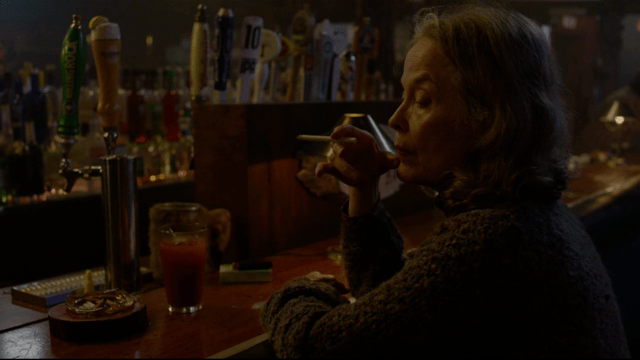
Read through the Bloody Mary food network, Sarah was piloted by Judy to that particular stool in that particular bar. Tearing out the trucker’s throat clearly echoes the lioness tearing open the water buffalo such that Sarah may be acting predatorily in soliciting sexual harassment. Sarah, at least the Judy part, knew just as most spectators knew, through familiarity with the cinematic grammar of misogyny invoked in the scene, immediately and upon the first vocalization of the man, that a scene of violence was about to unfold. What’s important about Sarah being piloted here by Judy is then the invitation for spectators to identify and/or empathize with her narrows. Judy is supposed to be an evil alien other. Yet I find it impossible not to identity and empathize with Sarah encountering threats of sexual violence just for being female and alone in a socially-shared space, even if she is Judy. The structure of misogyny laid bare here is reprehensible regardless of whether or not Judy is inside Sarah’s human body. That’s extremely important because it puts paid to the oft-rehearsed, ethically-flawed argument that men shouldn’t sexually assault women because every woman is a mother or sister or daughter. That argument respects only relationality to men. Here, in this scene, Sarah pulls her face aside. She is represented as something radically alien, so conventional relational markers like widow to Leland or mother to Laura dissolve. As such, if the depiction of misogyny in this Bloody Mary scene remains upsetting it accomplishes something as unusual as it is forceful in its cinematic
depictions.
Just think about how casually the PG-rated family film Back to the Future portrayed Marty and George McFly devising a plan that involved sexually assaulting Lorraine as well as the scenes of Biff actually assaulting her in the school cafeteria, and then again in the car on the night of the dance. By contrast with scenes that normalize misogyny, this Bloody Mary scene is not easy to dismiss or forget. What’s more, Sarah’s Bloody Mary food network provides a counterbalance in conversation with what Lindsay Stamhuis has pointed out in her brilliant address of allegations that David Lynch’s works have a consistent “woman problem.” Like Stamhuis, I consider the violence against women in The Return to be intensely frequent but also productively complicated. The Bloody Mary food network doesn’t exculpate the series from its fascination with damaging women, but it does provide a systematic way to interrogate what the show does with that violence.
To complete the Bloody Mary food network, the drink changes hands in its final appearance from Sarah Palmer to Bradley Mitchum. Sitting in the back of the Mitchum brothers’ limo is the restored Agent Cooper, Bradley and Rodney Mitchum, and Candie, Mandie, and Sandie. As Cooper sips a hot coffee, Candie finishes making Bradley’s Bloody Mary and hands it to him. In the ensuing conversation, the Mitchums discover that the man they thought was their insurance agent savior is an F.B.I. agent. Cooper assures them that he’s seen that they have hearts of gold and he’ll clear their history with law enforcement. Like everything Cooper says after recovering from the coma, this statement feels entirely earnest.
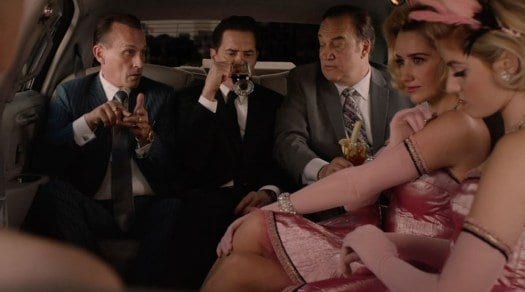
However, even though Cooper believes what he says, spectators should find his assessment unsettling at best. Regardless what the Mitchum brothers have done for the Jones family, they still
accumulate enormous wealth through the gambling industry that exploits people’s weaknesses
and desperation, and we can’t know for sure in what other industries they operate. Plus, the only
angst they’ve shown about killing people was about having to wait several hours before doing it.
Recall how the arrest of Ike the Spike was a relief to them just because it meant saving money on
a hit contract. Think also of Cooper’s statement in the context of Candie, Mandie, and Sandie. Throughout The Return there are bits of dialogue that suggest the Mitchums’ employment, if that’s the accurate word, of Candie protects her from an unspecified threat if they were to let her go. If their maintenance of Candie is evidence to Cooper of their golden hearts, then he is oblivious to the problems of patriarchal misogyny. Candie’s every day is shaped by a uniform that objectifies her as an object for consumption, a situation reinforced by the repetition of her conspicuously presenting food, and, of course, her name is Candie.
That Candie puts a Bloody Mary in Bradley’s hand as Cooper proclaims the Mitchums’ goodness connects the suspicion it sews about Cooper’s susceptibility to masculine overconfidence and obliviousness to privilege with the structures of misogyny that Sarah’s Blood Mary scenes brought into view. This moment underscores and extends Todd VanDerWerff’s insight, delivered by the way via food metaphor, in his Vox article on Twin Peaks misogyny: “This idea – that the kind of carefully constructed small-town utopia the American dream is built on comes with a hefty side of misogyny and violence against women – has been present in a lot of Lynch’s work” (VanDerWerff). I’d extend
that remark beyond the side dish to argue that the misogynistic violence of heteropatriarchy central to capitalist ideology in the US is a Twin Peaks daily special.
The conversation and collaboration in the limo is the inverse side of the same structures of misogyny that Judy cultivates, so if Cooper seems to fail to “save” Laura or Carrie, it’s because he does not grasp the story of all the girls down the lane that the Bloody Mary helps to tell. But don’t worry. While the Bloody Mary food network illuminates deep flaws in Agent Cooper’s character, another food network indicates a path of hope and change.
Part of what makes The Return of Twin Peaks such a challenging and rewarding text is that it contains multiple narrative networks with divergent outcomes and implications. The food network of hope and change connects Big Ed Hurley with Nadine Hurley, Norma Jennings, and Bobby Briggs. Ed and Norma are figures of hope through consistency while Nadine and Bobby configure hope through change.
Let’s enter this food network through the scene where Ed invites Bobby to join Norma and himself for dinner at her back booth in the RR Diner. Convincing Bobby to overcome his hesitation about intruding with the remark, “It’s no good eating alone,” Ed solidifies his constancy of character from the original seasons. Over two and a half decades, Ed’s feelings for Norma remain undiminished as does his genuine sense of community and the common good.
The RR is one of the few spaces where Ed can coexist with Norma and realize just a sliver of the love they feel for each other, yet he doesn’t pause a beat in sharing that space for Bobby’s good.
Perhaps this is part of Ed and Norma’s connection, a mutual passion for the socially-shared food place of community that is the RR. Ed’s gesture is caring, but at this point in The Return it’s also
tragic as the decades of negotiating his feelings and respect for, as well as commitments to, the
people in his life remain locked inside an impossible situation.

Against this backdrop of Ed’s constant caring combined with tragedy, the radical changes that Bobby has undergone in the same decades are clear. In the original seasons and Twin Peaks:
Fire Walk with Me, Bobby was a disaffected teen who revelled in his privileged position, demonstrating not a whit of love or care for Laura Palmer. He reacted to the news of her death by
seeking revenge on his romantic rival, James Hurley. But in this The Return RR scene, adult
Bobby has let go of the negative narcissism that defined his young adulthood. He now serves as a
law enforcement officer and has integrated into the community such that he enjoys dinner with
the closest family of his former romantic rival.
Bobby’s capacity for change, in particular for reconfiguring his entanglement with the structures of misogyny, is cemented in a subsequent RR Diner node of this food network. In a family conference over coffee after Becky has attempted to kill Steven Burnett (and Gersten Hayward), Bobby is clearly the only one capable of helping her extricate herself from the disrespect and violence of men like Steven. Shelly is stuck in a repeating loop of self-subjection to the most explicitly misogynistic men, and even the friends she chooses lend to the repetition as they dissuade her from questioning Becky’s relationship, saying, “everyone loves Steven.”
Shelly’s abrupt departure from the RR to catch a kiss and plan a rendezvous with Red convey that she’s not changed from her days with Leo and the young misogynistic Bobby. Unlike Shelly, Bobby has fully rejected the Leo and Red approach to women and thereby presents a spark of hope. Even so, this spark shines in its moment against the still-tragic darkness of the Ed eating RR Diner soup alone at his Gas Farm desk at the end of this part. The hope Bobby embodies appears tempered by the static internalization Ed’s constancy rehearses.
Like Bobby, Nadine has changed in the decades between the original seasons and The Return. Through her regular tuning in to Dr. Amp’s broadcasts, Nadine has found a way to build a better life by dissolving the bond she’s held onto between her and Ed. All the nights in The Return showing Nadine sipping on large smoothies while Dr. Amp punctuates his self-help monologues with sips of lingonberry extract and artesian well water have added up to a breakthrough to happiness. It’s significant that their consumption of nourishing foods complements Dr. Amp’s rehearsal of the power to dig oneself out of at least some of the shit of life. Perhaps Nadine’s smoothies call back to Ben Horne’s switch from cigars to carrots just when he began trying to be a good person in Season 2.

Immediately after Nadine tells Ed about her epiphany and insists he go live the rest of his life in love with Norma, he zooms his truck to the RR to tell her, but his news gets interrupted by Walter, Norma’s diner franchise partner/advisor. In Ed’s attempt to endure this emotional rollercoaster ride, he orders a coffee, and, under his breath, a cyanide tablet. But this interruption features Norma making a major food-focused decision. The business of scaling up to franchise the RR diminished = the quality of the cherry pies at the other branches. And it’s nearly impossible not to read a hard-won autobiographical allegory here for Lynch’s experience with the original seasons of Twin Peaks where he learned, and got burned, by having to surrender quality control as the series scaled.
Norma’s steadfastness on the pies parallels her steadfastness for Ed, and the scene closes with them getting engaged and sharing a loving kiss. This food network concludes on one of the happiest multi-character arcs in The Return and comes across as sincerely hopeful by contrast with Cooper’s supposed closure of the Bloody Mary network. In this network, good people don’t accept negative standards, and the people who previously acted negatively and misogynistically embody the prospect of change and how much good it can produce in the world.
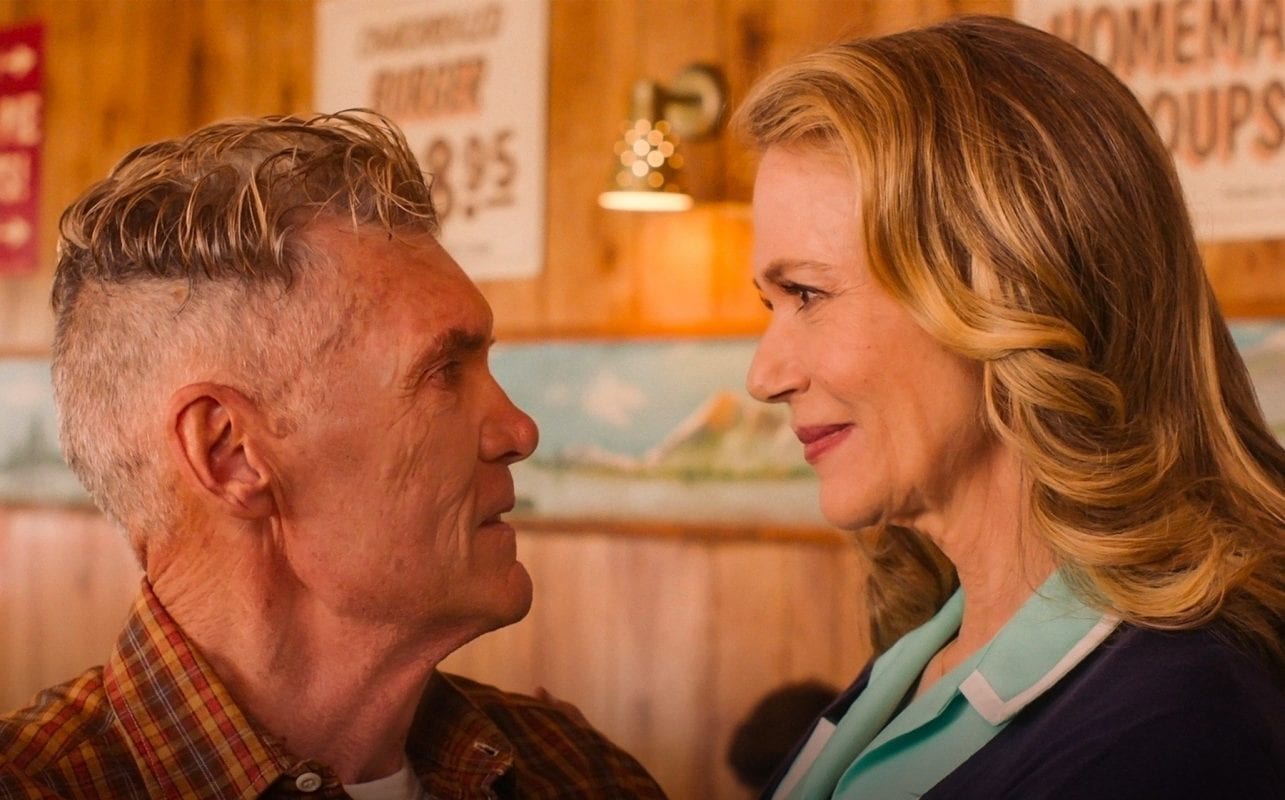
Still, these beautiful narrative turns are hard-won, making Twin Peaks a series that engages and explores structures of misogyny as deeply and strongly wired into the social imaginary. One doesn’t simply get woke, as from a dream. Rather, one lives inside a dream and must continue working and critiquing and questioning how to escape the marionette wires of misogyny built into that dream without losing too much of oneself or tangling others inside the loosened lines. These and many more food networks coexist in the complicated world of Twin Peaks, and, as spectators, we have the opportunity to assemble and analyze particular networks as well as put the multiple networks into conversation. And the key to this critical food network analysis, as David Lynch likes to put it, is to keep our eyes on the donut.
Finally, I would be thrilled to know what occurs to you from running queries through the database embedded here and reacting to what returns. Please consider sharing your investigations in the comments here and/or by connecting with me directly.
Works Cited:
Altman, Mark. Twin Peaks Behind the Scenes: An Unofficial Visitor’s Guide to Twin Peaks.
Pioneer Books, 1991.
Bolin, Alice. Dead Girls: Essays on Surviving an American Obsession. William Morrow, 2018.
Bushman, David, and Arthur Smith. Twin Peaks FAQ: All That’s Left to Know about a Place
Both Wonderful and Strange. Applause Theater and Cinema Books, 2016.
Hageman, Andrew. “Dale Cooper and the Mouthfeel of Twin Peaks.” Food on Film: Bringing
Something New to the Table, edited by Tom Hertweck, Rowman & Littlefield, 2015, pp.
141-157.
—. “A Reflection on Why Agent Tamara Preston Has the Stuff.” 25YL – Damn Fine TV/FILM,
20 Jul. 2018, https://25yearslatersite.com/2018/07/20/a-reflection-on-why-agent-tamara-preston-has-the-stuff/.
Hallam, Lindsay. Twin Peaks: Fire Walk With Me. Auteur, 2018.
Kessler, Ronald. The Secrets of the FBI. Broadway Paperbacks, 2012.
Lavery, David. “The Semiotics of Cobbler: Twin Peaks’ Interpretive Community.” Full of
Secrets: Critical Approaches to Twin Peaks, edited by David Lavery, Wayne State UP,
1995, pp. 1-21.
Piatti-Farnell, Lorna. “‘That Cherry Pie is Worth a Stop’: Food and Spaces of Consumption in
Twin Peaks.” Return to Twin Peaks: New Approaches to Materiality, Theory, and Genre
on Television, edited by Jeffrey Andrew Weinstock and Catherine Spooner, Palgrave,
2016, pp. 87-104.
Stamhuis, Lindsay. “It’s a World of BOBs: Sexual Violence Againt Women in Twin Peaks.”
25YL – Damn Fine TV/Film, 13 Apr. 2018, https://25yearslatersite.com/2018/04/13/its-a-
world-of-bobs-sexual-violence-against-women-in-twin-peaks/.
Twin Peaks: The Return, Written by Mark Frost and David Lynch, directed by David Lynch,
Showtime, 2017.
Twin Peaks: Fire Walk With Me. Directed by David Lynch, performances by Sheryl Lee, Ray
Wise, Kyle MacLachlan, and Chris Isaak, CIBY Pictures, 1992.
VanDerWerff, Todd. “Episode 10: The Series Delves Deeper into Violence Against Women and
American Misogyny.” Vox, 17 Jul. 2017,
https://www.vox.com/culture/2017/7/17/15980296/twin-peaks-episode-10-recap-the-
return-misogyny.


